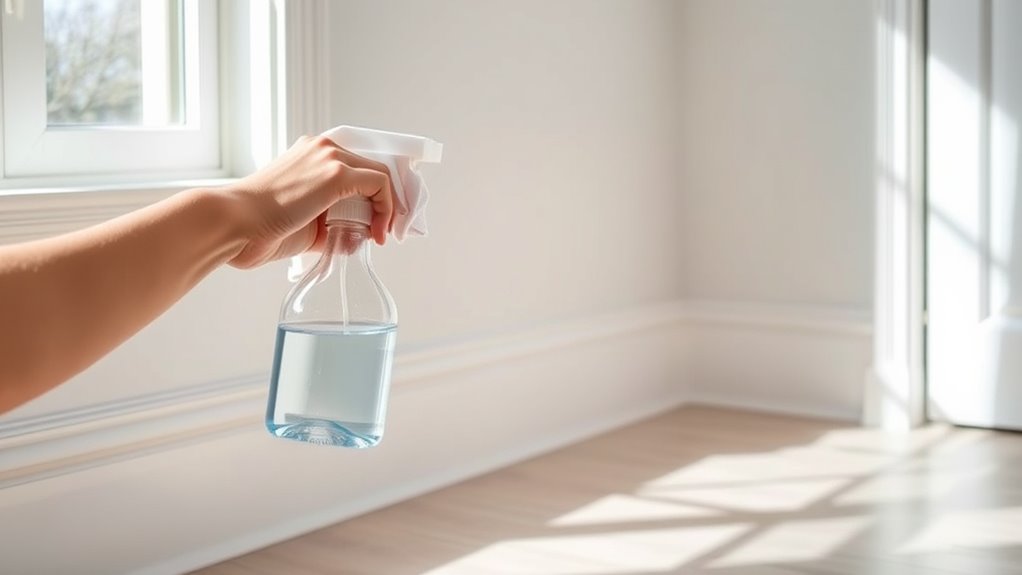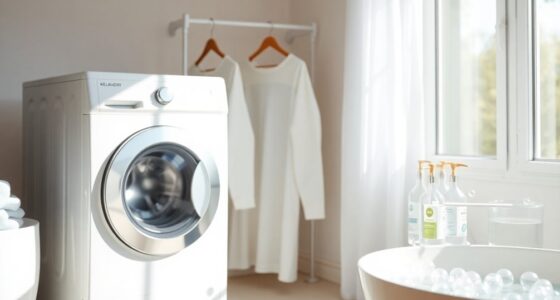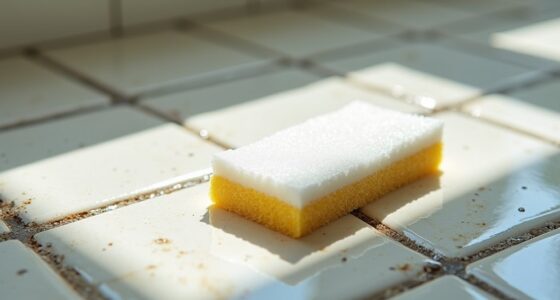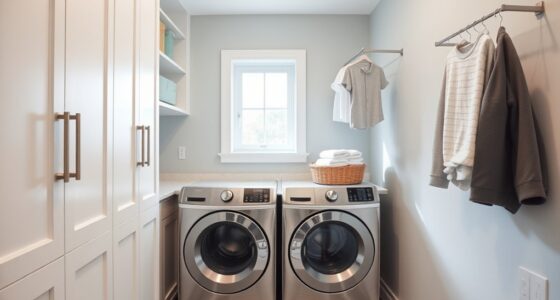To quickly clean baseboards, start by attaching a microfiber cloth or a soft-bristled brush to your vacuum for easy dust removal, running it along the length of the baseboards. Follow up with a slightly damp microfiber cloth to wipe away remaining grime, using gentle, steady strokes. For stubborn spots, a light scrub with a soft brush and mild cleaner can help. Keep your baseboards fresh and spotless—there’s more useful tips if you keep going.
Key Takeaways
- Attach a vacuum with a brush or upholstery tool to quickly remove dust and cobwebs along the baseboards.
- Use a microfiber cloth, slightly dampened with water or mild cleaner, for a streak-free wipe-down.
- Combine vacuuming and damp wiping for thorough cleaning in less time.
- Employ soft-bristled brushes for stubborn grime without damaging paint or wood surfaces.
- Regularly dust and wipe every few months to maintain clean baseboards efficiently.
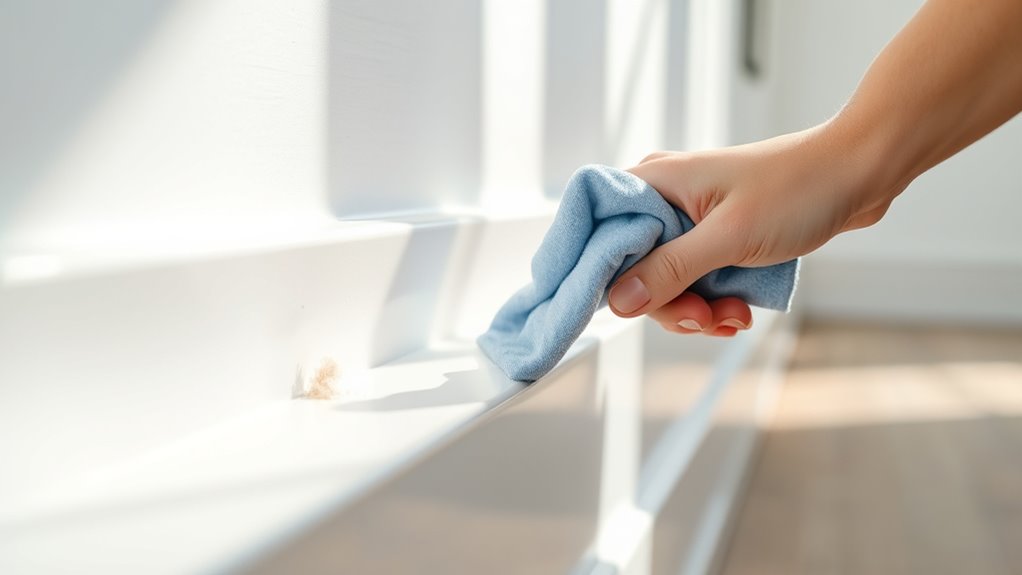
Cleaning baseboards doesn’t have to be a time-consuming chore. With a few simple tools and techniques, you can make this task quick and effortless. One of the easiest ways to start is by using vacuum attachments. Attach a brush or upholstery tool to your vacuum cleaner, and you’ll save yourself from bending down with a cloth or duster. Run the vacuum along the length of each baseboard to suck up dust, dirt, and cobwebs. This method is especially effective for removing loose debris and works well on both painted and wood baseboards. It also minimizes the need for additional cleaning products, making the process faster and less messy.
After vacuuming, you’ll want to tackle any remaining dust or grime that’s more stubborn. This is where good dusting techniques come into play. Use a microfiber cloth, which is excellent at trapping dust without spreading it around. For a quick, streak-free finish, dampen the cloth slightly with water or a mild cleaning solution if needed. Wring out excess moisture so you don’t damage the paint or finish. Wipe along the length of the baseboard in smooth, steady strokes, applying gentle pressure to lift dirt away. If you encounter stubborn spots, a soft-bristled brush can help loosen grime without scratching the surface. For high or hard-to-reach areas, a long-handled duster or an extension pole with a microfiber attachment makes the job easier. Incorporating proper cleaning tools can further enhance efficiency and protect your surfaces.
For a more efficient approach, combine these methods. Start by vacuuming to remove loose dust and cobwebs, then follow up with a quick wipe-down using a damp microfiber cloth. This two-step process ensures you’re not just moving dirt around but actually lifting it away. If your baseboards are especially grimy, you might want to use a gentle all-purpose cleaner on your cloth, but always test a small area first to avoid damage. For regular maintenance, dusting techniques are enough to keep your baseboards looking fresh. For deeper cleaning, especially in homes with pets or high traffic, repeat the process every few months to prevent buildup.
Frequently Asked Questions
How Often Should I Clean My Baseboards?
You should clean your baseboards at least once every two months, but cleaning frequency depends on the baseboard materials and your home’s environment. If you have painted or lacquered baseboards, a softer approach works best, while wood or vinyl may need more regular attention. Regular cleaning keeps dust and dirt from building up, maintaining your space’s cleanliness and appearance. Adjust the schedule based on your home’s dust levels and foot traffic for best results.
Can I Use Vinegar to Clean Baseboards?
Did you know that vinegar cleaning is a popular natural option for many household tasks? Yes, you can use vinegar to clean baseboards, making baseboard maintenance simple and eco-friendly. Mix equal parts vinegar and water, then wipe down your baseboards with a cloth. This method effectively removes dirt and grime without harsh chemicals, leaving your baseboards clean and fresh. Just avoid using vinegar on delicate paint finishes to prevent damage.
Are There Eco-Friendly Cleaning Alternatives?
Yes, there are eco-friendly cleaning alternatives you can use. You might try biodegradable solutions and natural cleaning agents like baking soda, lemon juice, or castile soap. These options are effective and safe for the environment, reducing chemical use in your home. Simply mix them with water, and you’ll have a natural, non-toxic way to clean your baseboards quickly and efficiently, all while being gentle on the planet.
How Do I Remove Stubborn Stains From Baseboards?
To remove stubborn stains from your baseboards, you should act quickly, use gentle yet effective solutions, and repeat the process if necessary. Start by mixing a mild detergent with water, then gently scrub the stain with a soft cloth. For pet stain removal or paint touch-up marks, apply a small amount of baking soda paste or a specialized cleaner, then wipe clean. Patience and consistency make stubborn stains vanish.
Is It Safe to Use a Steam Cleaner on Baseboards?
Using a steam cleaner on your baseboards can be safe if you consider steam cleaner safety and your baseboard material. You should check the manufacturer’s recommendations to verify it won’t damage the finish or paint. For wooden or painted baseboards, use a low steam setting and keep the cleaner moving to prevent moisture buildup. Always test a small, hidden area first to avoid any potential damage.
Conclusion
Now that you know these quick methods, cleaning your baseboards becomes effortless, efficient, and even enjoyable. With a simple approach, you’ll remove dust, dirt, and grime in no time. Embrace these techniques to keep your space fresh, your home spotless, and your mood uplifted. Remember, a clean baseboard is a reflection of a tidy home, so stay consistent, stay simple, and enjoy the fresh, clean look every day.
